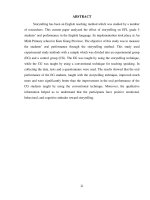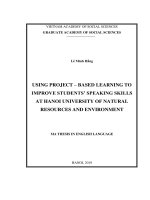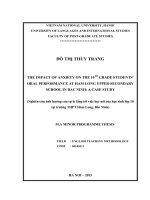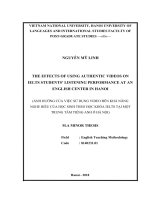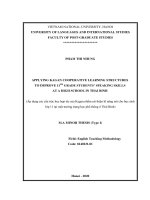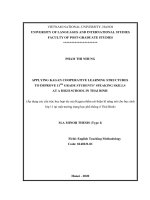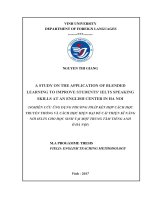A study on the opportunities for and constraints on developing students’ oral skills at an upper-secondary school
Bạn đang xem bản rút gọn của tài liệu. Xem và tải ngay bản đầy đủ của tài liệu tại đây (256.83 KB, 44 trang )
PART ONE: INTRODUCTION
1. Rationale
In the context of Vietnam’s economic reform and global participation, English plays
an extremely important role in helping its human resources to communicate with the rest of
the world. Therefore, there has been a great demand for teaching and learning English all
over the country for various purposes.
However, how to teach and learn English in general and English speaking skill in
particular effectively is a matter of controversy. Speaking skill should be kept in mind to be
the most popular and affective way of communication.
Being an English teacher at Doluong 1 Upper Secondary School (DL1SS) I realize
that there are many students who are good at writing and reading find it difficult to speak
English.
For these reasons, in this study , I would like to investigate the recent reality of
teaching and learning English speaking skill in DoLuong 1 Upper-Secondary School
(DL1SS), a school in the countryside of Nghe An, a province in the Center Vietnam. The
aim of the study is to identify the reasons for students’ poor oral competence so that
appropriate solutions could be proposed to the question under investigation.
2. Aims of the study
This study is aimed at:
-investigating the recent reality of teaching and learning English speaking skill at
Doluong 1 Upper-Secondary School (DL1USS).
-identifying the opportunities for and constraints on developing students’ oral skills
as perceived by the teachers and students at DL1USS .
-proposing some solutions with the hope of helping English teachers improve their
teaching speaking skill and students’ learning ability.
3. Method of study
In order to achieve the aims of the study, questionnaires, class observations and
interviews were used to collect data and information from the teachers and students at
Doluong 1 Upper-Secondary School (DL1USS).
1
4. Scope of the study
With the above aims, this study is limited to the exploration of opportunities and
constraints as perceived by the teachers and students of Doluong1 Upper-Secondary School
in Nghe An with regard to the teaching and learning of English speaking skills and some
recommendations. The study only focuses on 26 of 43 classes, where there are teachers and
students who are implementing the two new English syllabuses for grades 10 and 11,
published by the Ministry of Education.
5. Design of the study
The study consists of three parts:
Part One: Introduction presents the rationale, the aim, the method, the scope and the design
of study.
Part Two: Development consists of following chapters:
Chapter 1: Literature Review aims at the basic theoretical background which consists
of: Definition of Speaking skill, Positions of speaking in language teaching programs,
Difficulties in and constraints on learning to speak a foreign language, and Factors affecting
students’ participation in speaking activities.
Chapter 2: Methodology focuses on the recent situation of English teaching and
learning at Doluong 1 Upper-Secondary School and the Research methodology. The
methodology includes the participants and instruments of the study.
Chapter 3: Data analysis and discussion of the results of the questionnaires, class
observations and the interviews will be conveyed in this chapter.
Chapter 4: This chapter proposes the findings concluded from the results of the
previous chapter and some recommendations for teachers and students at DL1USS in the
hope of helping to develop students’ oral skill.
Part Three: Conclusion summarizing all the issues in the research contains Limitation of the
study, Recommendation for further study and Conclusion.
2
PART TWO: DEVELOPMENT
CHAPTER 1: LITERATURE REVIEW
To begin with the study, in this chapter, the researcher will present some theoretical
background so that the study will be based on. This chapter includes 4 small parts as follows:
Definitions of Speaking skill, The position of Speaking in language teaching programs, What
makes speaking a foreign language difficult, and Factors affecting students’ participation in
speaking activities.
1.1. Definitions of Speaking skill
Speaking skill of a second or foreign language is regarded as a very complicated
task. First of all, speaking is used for variety of purposes and each purpose involves in
different skills. In a casual conversation, for instance, speakers’ purposes may be to make
social contact with others, to establish sympathetic relationships or to spend time chatting
harmlessly with someone. On the other hand, the purpose may be to find out or to express
their opinions or to clarify information. On other occasions, speakers wish to give
instructions, persuade people or get things done. They may want to describe things, to
complain about people’s behaviors, to make requests or to entertain people with jokes. Each
of these different purposes for speaking implies knowledge of the rules that account for how
spoken language reflects the context or situation which speech occur in, the participants
involve in, and their specific roles or relationships, and the kinds of activities the speakers
are involved in.
According to Brown and Yule’s (1983: 127), speaking skill consists of short,
fragmentary utterance, in a range of pronunciation. There is often a great deal of repetition
and overlap between one speaker and another and speakers usually use non-specific
references.
Brown (1994: 45) and Burns & Joyce (1997: 29) define that speaking is an
interactive process of constructing meaning that involves producing, receiving and
processing information. When participating in communicative activities, the speaker should
choose the correct vocabulary to describe the things they want to say about, to rephrase or
emphasize words to clarify the description to produce the expected pattern of specific
discourse situations.
3
Looking through the English language teaching methodology literature, we can
easily see that there have been many different definitions of speaking skill proposed by
linguists, but no definition is satisfactory. According to Fisk (1990:1) oral communication
(speaking skill) is one of those human activities that everyone recognizes but few can define
satisfactorily.
Despite the definitional diversity, in the present study, speaking skill is defined as
“the range of exercise types and activities with a communication approach is unlimited,
provided that such exercises and activities enable learners to attain the communicative
objectives of the curriculum, engage learners in communication and require the use of such
communicative processes as information sharing, negotiation of meaning, and interaction”.
(Richard and Rodgers, 1986: 165)
In conclusion, speaking skill is one of the key modes of human communication, and
one of the macro skills that language students should be helped to develop for their
communicative purposes. For that reason, teachers should help their students to improve
their speaking and overall oral competence.
1.2. The position of speaking in language teaching programs
It is known that language is an effective means of communication through which we
can convey our ideas, our thought, or our desires. Language helps us clarify what we mean.
Without language, human beings have never achieved such developments as they have done
these days. It is language that makes human beings distinctive from animals.
Many language learners consider speaking ability the measurement of knowing a
language. In other words, speaking skill is very important in language teaching and learning.
If learners do not learn how to speak or not to get opportunities to speak, as many think, they
may soon lose their interest in learning, and learning the language is the way how to speak
the language.
Bygate, M. (1987: 5) stresses that speaking “is also a medium through which much
language is learnt, and which for many is particularly conductive for learning”
Nunan (1991: 279) states that success in an oral conversation is measured in terms of
the ability to carry out a conversation in the (target) language. If a student doesn’t know how
to speak and has no chance to speak in the language classroom, he will lose interest in
4
learning. In the speaking class, on contrary, if the teacher doesn’t organize right and positive
activities, the speaking a language will become less and less boring.
Sharing the same ideas, Richard, A. (1991: 165) cites that it is the speaking skill that
helps learners to have communication which is the proper aim of language teaching.
According to Byrne (1991: 45), while listening and reading are regarded as receptive
skills, speaking and writing are productive skill. Speaking not only helps students to
communicate well and exchange information and culture with others but also promote the
integration of speaking, listening, reading and writing in the ways that reflect natural
language use.
Similarly, Brown, G and Yule, G (1992: 256) point out that speaking plays an ever
important role in a very transactional intention, that is, to make clear what they want to say.
From those points, we can come to a conclusion that speaking skill is one of the most
necessary skills in language teaching program. It suits the development rules of human
beings as one can speak before he can read and write. That is the reason why speaking skill
should be taught in the language room.
1.3. What Makes Speaking a foreign Language Difficult?
1.3.1. Characteristics of spoken language
Speaking in a second or foreign language has often been viewed as the most
demanding of the four skills. When attempting to speak, learners must concentrate their
thoughts and encode their ideas in vocabulary and syntactic structures of the target language.
According to Kathleen M. Bailey and Lance Savage (1993: 18), depending on the
formality and importance of the speech situations as well as their own personal linguistic
propensities, the learners may also attend to monitor their output (speaking skill).
These two linguists also add that in conversations and other interactive speech
events, the speakers must attend to the feedback from their interlocutors and observe the
rules of discourse used in the target culture. Phonological considerations add to the
difficulties to the task, especially for adult learners, as speakers strive to achieve “good”
pronunciation. The speed of such interaction is also an issue because their may not be
adequate time for processing either outgoing speech or incoming messages at the typical rate
of native-speaker interactions.
5
All of these factors combine to make speaking in a second or foreign language a
formidable task for language learners.
Sharing this idea, Penny Ur (1996: 120) shows the four following prerequisites of a
successful speaking activity in the classroom:
-Learners talk a lot: during speaking skill activities, learners should have chances to
talk a lot to develop their oral skill.
-Participant is even: all learners are involved in the activities and their distribution
for speaking chance is the same.
-Motivation is high: all the learners are interested in talking and positively participate
in speaking activities.
-Language is of an acceptable level: this means that the language used by teachers
and learners to express their ideas and thoughts is understandable to others.
Thus, from the characteristics of spoken language mentioned above, it can be
inferred that teachers have an important duty to find out the appropriate methods to teach
their students.
1.3.2. Difficulties in learning to speak a foreign language
In addition to the linguistic complexity which makes speaking a difficult skill to be
acquired, there are pedagogical difficulties. These difficulties are understood as the learning
environment such as the large size of classes, deficient facilities and difficult syllabuses.
In large classes, students are usually different in levels of language proficiency, in
learning style and even in general attitudes towards the language, which causes a lot of
challenges and makes teachers feel troublesome and stressed to make effective classroom
management. As Ur (1996: 303) says that teachers of large classes also face with the
problems of discipline, creating effective learning environment for all, finding suitable
materials, and activating all students, especially, silent ones.
Teaching aids such as pictures, maps, photos, samples of real objects, and so on serve
as a tool to maximize students’ opportunities to practice and help to make the learning
environment better to carry out speaking activities. If facilities are not enough and not
interesting, students will be de-motivated and the lessons will not be successful as expected.
Syllabuses also play an important role in the success of speaking lessons. If the
contents of the syllabuses are familiar, students will be excited and positively participate in
6
the activities. In contrary, if the syllabuses are strange and difficult, students will be de-
motivated or keep silent.
Thus, in order to involve students in communicative activities, it is necessary for
teachers to realize factors affecting students’ participation in communicative activities as
well as to find out solutions to the problems.
1.3.3. Constraints on learning to speak a foreign language
Constraints on learning to speak a foreign language are thought to be socio-physical
constraints. It means that these constraints come from inner students.
It is often thought that the ability to speak a language is the product of language
learning. Classroom activities play an important role in a language course because speaking
activities in classroom can help develop students’ ability to express themselves. In fact, not
all the speaking lessons take place as successfully as the teachers expected. Sometimes,
teachers find disappointed by such problems as pointed out by Ur (1996:121):
- The students are often inhibited about trying to say things in a foreign language in
the classroom because they feel very shy of being paid attention to what they say, or
fearful of losing face, or they are even worry about making mistakes.
-The students have nothing to say. That is, students find it difficult to select suitable
words from their store of language clustering to express their ideas and thoughts, and
in some cases they lack knowledge of the matters being discussed.
-Students’ participation is uneven and low. This problem often occurs in large
classes, especially, in speaking activities. Stronger students tend to dominate the
groups or class, whereas weaker ones tend to speak very little or keep silent.
-Students tend to use their mother tongue instead of the foreign language. That is,
while some students are very self-confident of their ability to speak English, others
are anxious about speaking. Some may show their anxiety in silence for fear of
making mistakes or being laughed at by their friends. Others show their anxiety in
returning to using their mother tongue when they have to communicate something
unfamiliar or complicated.
In conclusion, teachers should try their best to understand the constraints on students’
learning to speak a foreign language and find out suitable methods to help their students to
overcome the constraints as well as to encourage students to participate in speaking activities
to help develop their speaking skill.
7
1.4. Factors Affecting Students’ Participation in Speaking Activities
1.4.1. Teacher Variables
In the traditional teaching method, a teacher plays the role of the controller or
manager of the class. The teacher can teach anything they find necessary and students are
only the listeners. Students have to do what their teacher tells them. Teacher can ask students
questions and their students have to answer. Nevertheless, the traditional teaching method
has many limitations and has been criticized recently.
Different from the teacher in the traditional teaching method where the role of the
teacher is considered the most important, the teacher in CLT classes has many different
roles. At times, he is the controller or manager of the classes when establishing situations to
promote communication; during the activities, he works as the facilitator and adviser,
answering students’ questions; he is the co-communicator when involving in the
communicative activities with students; he is the prompter when his students get lost or
cannot think of what to say next; he is also the observer to observe what students do in oral
communicative activities so that he can give their students useful group and individual
feedback; furthermore, he is the feedback providers when his students have difficulty in the
middle of a speaking activity and helpful and gentle correction may get students out of
difficult.
Wilkins (1974:53) states that the teacher himself is the one important variable in the
learning situation. The important role of the teacher is also acknowledged by Kay &
Christison (1978: 14), who argue that a teacher has to play different roles such as an
instructor, a consultant, a supervisor, a communicator, and a controller. They should be able
to give instructions clearly, encourage the students to actively participate in the learning
process and to interact with each other. Where necessary, the teacher is supposed to help
their students with their difficulties in linguistic matters as well as background knowledge.
Sharing these opinions with Kay& Christison (1978: 65), Cross (1992: 54) adds that
the teacher is the manager of the activity and must plan it, organize it, start it, monitor it,
time it and conclude it. The teacher is active and, remaining sensitive to the atmosphere and
pace of the group and noting persistent errors for remedial teaching. Should this task be seen
to be going drastically wrong, the teacher will stop it and revert it to some form of practice
before starting group work again.
8
Obviously, the role of the teachers in CLT classes is very difficult but extremely
important. So as to become good teachers, they always have to try their best to fulfill their
duties. Teachers should always give students chances to express their individuality by asking
them to share their ideas and opinions with others.
Harmer (1996:1) suggests some generalization about good teacher qualities: “teacher
needs to do everything possible to create a good rapport with their learners. Partly this
happens by providing interesting and motivating classes; partly this comes from such things
as treating all the learners the same … and acting upon their hopes and aspirations. Most of it
depends on paying more attention to the learner than to the teacher”.
According to Nunan (1991: 279), when teaching speaking skill, teachers should offer
the five following features:
-Emphasizing on learning to communicate though interaction in the target language.
-Introducing authentic texts into the learning situations.
-Providing opportunities for learners to focus, not only on languages but also on the
learning process itself.
-Enhancing the learners own personal experiences as important contributing elements
to classroom learning.
-Attempting to link classroom language learning with language activation outside the
classroom.
In conclusion, as it is proved above, the role of the teacher is extremely important for
the process of teaching and learning languages.
1.4.2. Student Variables
One of the most important variables which have a great influence on teaching and
learning is students’ variable. Without students, there would be no class, no teaching and no
learning.
In class environment, students always have different relationships such as students to
their teacher, students to students, and students to materials.
It is considered that the relationship between students and their teacher is very
important. Once students have good relationship with their teacher, they will always take
part in the class activities, become involved in what is happening in the classroom, or even
volunteer to perform activities. In turn, if students do not have good relationship with their
teachers, they always show their resistance to class participation. Active students are those
9
who always show their desires to work on problems with their teachers, respond to their
teacher’s questions and those who can make their own opportunities for practice in using the
language inside or outside the classroom.
The relationship among students is established by their performing activities in
groups. Group work activities will be effective and successful if teacher’s teaching method is
easy and appropriate, and students’ levels of English proficiency are nearly the same.
Besides, during the lesson, there are also many other affective factors coming from students.
These factors such as students’ attitudes, anxiety, competitiveness, and other emotional
responses can help or hinder language learning (Krashen, 1985).
The relationship between students and materials is regarded as students’ success in
performing given activities. If the materials are up to their expectation and easy and
understandable to students, activities will be successful, but in turn, if the materials are too
difficult, there will be unwanted results. This problem can only be solved when the teacher
adapts and adjusts the materials.
1.4.3. Learning Environment and Text books
The environment in which students learn can greatly influence their academic
performance and well-being at school. The learning environment can be seen as physical
conditions, such as class size, chairs, desks, tables, lights, boards. It stands to reason that the
better the learning environment looks, the more it inspires the people inside it. In other
words, whatever a child’s academic ability, pleasing environment will definitely lead to
better attendance, improved concentration and a healthy dose of motivation.
According to Harmer (1992: 271), physical conditions have great impact on students’
learning as well as their attitudes towards the subject matter.
While learning environment can be seen as class size and facilities in class, the
textbooks and authentic materials (visual aids) can be considered important resources.
Textbooks are greatly important in language teaching program because they specify
goals and objectives. Textbooks play a vital role in forming comprehensible input, a
hypothesis defined by Krashen. Krashen (1981:126) states that “children progress by
understanding the language that is a little beyond them”. It means that if the contents of the
textbook are suitable and up to students’ knowledge, they will much help develop students’
speaking competence. Otherwise, if the contents of the textbooks are unsuitable and new to
10
students or much beyond students’ knowledge, it will be a very difficult job for teachers to
increase students’ language competence.
Authentic materials (visual aids) can be regarded as an important factor affecting
students’ learning situation. According to Lam (2003: 26), authentic materials may include:
tapes, tape-recorders, language laboratories, wall pictures, wall charts, flannel boards, other
display facilities, slides, film trips, films, televisions, radios, record players, video
recorders, and libraries.
To show the benefits from authentic materials, Betty Morgan Bowen, (1982:1) cites
that authentic materials “allow the teacher to talk less by dismissing the importance of the
verbal stimuli provided by the teacher’s voice and allow the students to talk more. This
visual rather than verbal approach results in less teacher’s talking time and more students’
participation.” It is true that authentic materials motivate students much, particularly when
they are too tired of doing many exercises. Students realize that learning with authentic
materials is so interesting and they will continue more on the lesson.
In addition, Betty Morgan Bowen, (1982:1) says that authentic materials “encourage
the learners to lift their eyes from their books, which make it easier and more natural for one
to speak to another.” In fact, different types of authentic materials can help to change the
atmosphere of the classroom and bring in the ‘real world’ which makes students think and
act just as in daily life.
However, there are different types of authentic materials to for the teacher to make
use of, but the teacher should not abuse them, otherwise, the students will be confused and
irritated. Teacher should consider his or her own ability as well as the students’ level of
proficiency in L2 and their interest to choose the most suitable ones.
CHAPTER 2: METHODOLOGY
This chapter includes two small parts. The first one is the context of the study. The
second part is the research methodology which consists of the participants and instruments
of the study.
2.1. The Context of the Study
11
The study was conducted at Doluong 1 Upper-Secondary school, which was founded
in 1959 and situated near the centre of Doluong Town, and with the staff of good, energetic
and enthusiastic teachers. The school is famous for its teaching and learning achievements in
other school subjects except for English. The reason for this is that English is a
comparatively new subject at this school. It was just introduced into the school curriculum
around 10 years ago. Before English, Russian used to be taught for over 35 years.
Although founded long ago, DL1USS is now having a difficult time. The school
does not have enough classrooms, thus, the teaching and learning take place both in the
mornings and afternoons. The school does not have a language lab for English classes; the
library has few English books, papers and magazines for students to read in their free time;
in the school, there is a serious shortage of modern facilities such as overhead projectors.
The school has only 3 overhead projectors for 43 classes and nearly 100 teachers of 12
different subjects.
Every year, the school receives about 700 students from 33 villages in the district. At
present, the school has 43 classes with the total number of students of over 2000.
Similar to any other school, there are 3 different syllabuses for 3 different grades.
Students of grade 12 are following the old syllabus published by the Ministry of Education
in 1986. This syllabus is considered out of date and will not be used next year. Students of
grades 10 and 11 are learning the two new syllabuses published by the Ministry of Education
in 2006 which are regarded as updated but very difficult ones.
The difficulties in teaching and learning English come firstly from students. In
general, students in the school differ in their level of language proficiency. Most students
coming from the centre of the town and nearby have been learning English since grade 6, a
small number of students started in grades 1 to 5. The rest coming from the rural areas where
there are very difficult situations for living and learning have been learning English since
grade 7, 8, 9 and even grade 10.
Although most students started learning English at the early age, many of them have
low proficiency of English because of their wrong attitudes to English learning, laziness as
well as the shortage of time for English. Besides this, all the new syllabuses of other
subjects which are considered difficult and overloaded have greatly affected students’
English leaning.
12
As for the staff of English teachers, the school has 11 English teachers consisting of
3 males and 8 females and aged from 25 to 56. Of the 11 English teachers who got B.A.
degrees, 6 graduated from the Foreign Language Department of Vinh University, 1 from
CFL-VNUH, and the other 4 from in-service centre in Vimh City. The youngest teacher
finished university last year, so she has nearly one-year teaching experience. The oldest one
has over 30-year teaching experience, however, he had been teaching Russian for 20 years
before starting his English teaching career about 10 years ago.
In terms of language teaching method, the teachers at DL1USS are familiar with the
traditional teaching method as they are used to teaching the old syllabuses and nearly half of
them have never been trained CLT as well as never been to a workshop or seminars. When
following the new syllabuses, they feel difficult to initiate activities and manage the class.
Fortunately, most of them have a great desire to acquire knowledge of communicative
competence to apply in teaching English.
2.2. The Research Methodology
2.2.1. The Participants
In order to gather information for the study, 160 students of grades 10 and 11 at
DL1USS were chosen to answer the questionnaire. These students, of whom 50% are female
and 50% are male students, are those who are learning the new English 10 and 11 syllabuses
published by the Ministry of Education in 2006.
10 English teachers aged from 25 to 56 were invited to answer the questionnaire. 2 of
them are male taking 20% and other 8 are female taking 80%. The teachers have the teaching
experience from 1 to 25 years.
25 students who were volunteers from 5 classes were chosen for the interview after
the class observations by the researcher. Of these students, there are 48% females and 52%
males.
5 of the 10 English teachers at DL1USS were invited to participate in the interview
after they had finished teaching their speaking lessons observed by the researcher. 1 of the
interviewed teachers is male, and 4 are female.
2.2.2. The Instruments of the Study
So as to gather more accurate data, both quantitative and qualitative methods were
used. Quantitative data were gathered through two survey questionnaires administered both
13
to the students and the teachers and qualitative data were collected via class observations and
interviews of teachers and students. Those two methods help the researcher get more in-
depth data for analysis.
2.2.2.1. The Questionnaires
The questionnaire is adopted since it is one of the most popular instruments in
gathering data. It is not only easy to prepare and can be given to large groups of subjects at
the same time, but also helps the researcher get a great amount of information within a short
period of time. The questionnaire is the most suitable method for a large-scale survey, the
aim of which is to find out participants’ opinions and attitudes.
In order to obtain sufficient data for this study, 160 copies of a questionnaire were
delivered to 160 students to gather information about students’ opinions of learning oral skill
to investigate the opportunities for and constraints on developing their oral skill. Of all these
students, 80 students are learning in grade 10 and another 80 in grade 11. The students are
using the new English syllabuses.
10 copies of another questionnaire were distributed to 10 teachers to collect
information about teacher’s perception of the difficulties they encounter in their teaching of
oral skill and their techniques in dealing with these difficulties.
2.2.2.2. Class Observations
The purpose of class observations is to know how the teachers perform their lessons,
what atmosphere is in the class, what students’ attitudes to the lessons are like, and what
interactions of students are during the lessons.
Thus, class observations are conducted to clarify some information which the
questionnaire cannot provide such as students’ real time-on-task and teachers’ instructional
strategies as well as students’ responses to classroom tasks.
So as to get more in-depth information, 5 class observations were made. The 5
teachers chosen to be observed are teaching at grades 10 and 11. The class observations were
carried out in 3 stages: before the lesson, during the lesson and after the lesson.
In before-lesson stage, the researcher focused on making contacts with the teacher to
know the teacher’s teaching points. In during-lesson stage, the observations were aimed at
the teacher’s techniques and the students’ interaction in class. In after-lesson stage, the
researcher concentrated on discussing and exchanging ideas with the observed teachers.
During the lessons the researcher used observation sheets as presented in Appendix 3
14
2.2.2.3. The Interviews
The aim of the interviews is to get more in-depth information about teachers’ and
students’ perception of the opportunities for and constraints on the development of oral skills
in English. The interviews were chosen since the interviews conducted in this study were
described as “semi-structured”, (Seliger and Shohamy, 1990) which consist of a number of
specific and defined questions determined beforehand, and allow some elaboration in
questions and answers.
After the questionnaires and class observations, two interviews were conducted by
the researcher to get information. One interview is for teachers who had finished their
teaching of speaking lessons observed by the researcher; the other is for students from the
observed classes.
The interview for teachers consists of 8 questions and the interview for students
includes 9 questions. Of course, the two interviews were performed in Vietnamese to make
sure that all the interviewees had no difficulty in comprehending the meaning of the
interview questions to answer them. After that, all the questions and answers of the
interviews are interpreted into English. The interviewer took notes while the interview was
going on, then key ideas were summarized by the researcher himself (Appendix 4 & 5).
CHAPTER 3: DATA ANALYSIS AND DISCUSSION
In this chapter, the results of the study are presented. The data has been collected
from the questionnaires, the class observations and the interviews. The result will be
presented in forms of tables and figures.
3.1. The Questionnaires
As mentioned above, 160 copies of a questionnaire were given to 160 students who
agreed to answer the questionnaire. Besides the students’ questionnaire, 10 copies of another
questionnaire were given to 10 teachers who are teaching English at DL1USS. The
questionnaire for students is in Vietnamese so as to make sure that there is no
misunderstanding. However, the questionnaires are then interpreted into English
(Appendixes 1& 2).
15
3.1.1. The Questionnaire for Students
3.1.1.1. Methodology
To make sure that the study has adequate reliability, a questionnaire is delivered to
160 students, 80 of whom are studying in grade 10, another 80 are studying in grade 11.
These grades are following the two new syllabuses published by the Ministry of Education.
This questionnaire (Appendix 2) consists of 8 questions with 8 categories:
-Students’ experience in learning English
-Students’ self-evaluation of their English proficiency
-Students’ stated purpose of learning English
-Students’ perception of the importance of speaking skill
-Students’ interest in speaking skills
-Students’ satisfaction with their speaking proficiency and the speaking activities
inside and outside the school
-Students’ opportunities for and difficulties in speaking skill
-Factors needed by students to develop their speaking skill
3.1.1.2. Results
Figure 1: Students’ experience in learning English
According to Figure 1, we can see that 129 of 160 students (80.6%) have been
learning English since grade 6 whereas 4 students (2.5%) say that they started at grade 10. In
fact, these students come from rural areas where they didn’t have a chance to learn English.
27 other students (16.9%) say that they have been learning English since grades 1, 2, 3, 4 or
5. Of course, these students come from the centre of the town or nearby.
Table 1: Students’ self-evaluation of their English proficiency
Questions No of responses Percentage
16
1. What is your level of English?
a. Excellent
b. Good
c. Neutral
d. Bad
e. very bad
3
25
76
46
13
1.8
15.6
47.5
28.7
8.1
2. In English, what skill are you good at?
a. Speaking
b. Listening
c. Reading
d. Writing
29
15
110
117
18.1
9.3
68.7
73.1
3. In English, what skill are you bad at?
a. Speaking
b. Listening
c. Reading
d. Writing
131
145
43
35
81.8
90.6
26.8
21.8
Table 1 shows us the results of students’ English proficiency. It can easily be seen
that although most students started learning English at early ages, their levels are not very
high. Only 25 students (15.6%) have a good level of English, 76 students (47.5%) have a
neutral level, 46 students (28.7%) have a bad level and 13 students have a very bad level. It
is surprising that the number of students who are excellent at English is too small, only 3
students (1.8%).
To answer Question 2, 117 students (73.1%) say that they are good at writing skill,
110 (68.7%) other students think that they are good at reading skill. Only 15 students (9.3%)
are good at listening and 29 students (18.1%) are good at speaking skill. Sadly, the number
of students good at reading and writing is over five times bigger than that of students good at
speaking and listening.
Contrary to the results of Question 2, the results of Question 3 tell us that 145
students (90.6%) are the worst at listening, 131 students (81.8%) are the worst at speaking
skill, whereas only 43 students (26.8) are the worst at reading and 35 students (21.8%) are
the worst at writing.
Table 2: Students’ stated purpose of learning English
Questions No of responses Percentage
What is your purpose of learning English?
a. To pass the exams
b. To apply for a job in the future
c. It is a compulsory subject
d. To talk to foreigners
125
97
130
56
78.1
60.6
81.2
35
17

